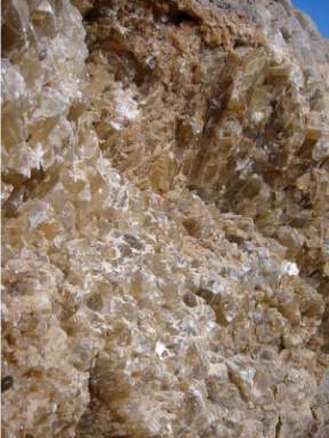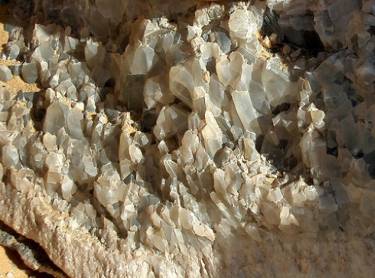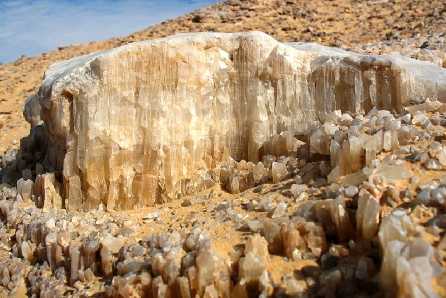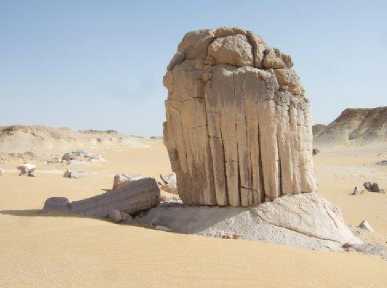The “Crystal Mountain” in Egypt
A subvolcanic vault, filled with crystals of a hydrothermal event

Egypt western desert Bahariya oasis crystal mountain
It should once be put right, that the crystals from the known Crystal Mountain (28° 26′ E and 27° 39′ N) between the oasis Bahariya and Farafra, northern of the White Desert, are no Quartz crystals. They are probably Barite (Schwerspat, BaSO4) and/or Calcite crystals (Kalkspat, CaCO3), which to ascertain at the hardness of the crystals easily. Quartz (SiO2) has the hardness 7, Barite and Calcite the hardness 3.5-3.0 (Mohs-scale). Quartz crystal can scratch glass, Barite or Calcite can it not.
The origin of this Crystal Mountain is interesting. The hill was opened during works at the road from Farafra to Bahariya by chance and destroyed in part. The material was installed into the road. Today is the Crystal Mountain a popular stop for the tourists.
Still more interesting is the geological context. The hill is not a paleokarst cave with columnar-shaped stalagmites. It is a subvolcanic vault, which was emerged probably during the Oligocene age. The visible layers are e.g. White Desert limestone of the Khoman Fm.* (Late Cretaceous age), as well as a younger coal seam and hydrothermal impregnated reddish to brownish ferruginous layers. The strata are broken or brecciated and intensely with each other folded. It is to be ascertained intense heat. The coal seam e.g. was transformed to anthracite (?). The crystals have increased out of climbed hydrovolcanic solutions. The hot solutions were high concentrated with BaSO4 and/or CaCO3, which had been solved from the sediments. The solutions have penetrated into all cavities. After cooling of the solutions the crystals could increase. It were formed columns or round domes with crystals within.
* The white limestone of the Khoman Formation is dated as middle to latest middle Maastrichtian (Gansserina gansseri and Contusotruncana contusa foraminiferal Zones). An open marine, warm Tethyan outer shelf environment of deposition is inferred.
“High grade Barite mineralization is found mainly in the form of different veins restricted to the ground surface of Bahariya depression. The barite veins trend in different directions and are actually associated with the major folds and faults that are restricted to the oldest rocks of Sabaya Formation which form the floor of the depression. The latter occurs within a major northeast trending belt of considerable extension about 100 km long and 40 km wide. Several other folds of the same or later tectonic phase but of lesser extension occur parallel to or perpendicular to the main anticlinal trend.
The Barite veins are widely distributed to the south of Gebel El Hafhuf which is composed of a rock sequence including sandstone, shale, limestone, phosphatic limestone and phosphatic calcareous sandstone. This succession is capped by the Oligo-Miocene basaltic sheet which takes the form of open circle of about 20 m thickness.
The barite veins are restricted to the fractures that are parallel to the main E-W or NW-SE striking faults in the Sabaya Formation. These veins occur subparallel sets with more than 7 m length and ranging in width between 0.5 to 4 m. These veins are numerous and distributed in association with tectonically formed fractures and fissures.
Barium was leached from the basaltic extrusion during high temperature circulation. Tertiary Oligocene basalt at Gebel El Hafhuf, Bahariya Oasis is related to continental intraplate volcanism. Fumarolic and geyser activities belong to Oligocene period were consider as gas maar resulting from a phreatic explosion.{google_map}Egypt Bahariya oasis {/google_map}
Release of sulphate fluids from the sulphate-rich minerals involved in the Brine deposits distributed within Bahariya Depression at the Quaternary, namely polyhalite, kieserite and kyanite.
Migration of these fluids through the deformed strata followed by barite mineralization as a result of a rapid primary precipitation at or above the sediment / fluid interfaces.
The crystals are transparent to translucent and are generally present in the form of angular to subangular shape.” |

|

Anthracite at the right side of the “archway”
|

“Archway” with firmly baked crystal structure
|
|

|
|

|

Crystal columns in a cavity
|
|

Hydrothermal formed columnar crystal structures
|

Crystal columns
|
|

Turbulent shapes
|

To anthracite transformed coal seam
|
|

|
|
|

|

|
|

|

Ferruginous strata with crystal inclusions
|
|

|

|
|

|

|
|

Blue coloration by trace elements
|

|
|

|

|
|
Not all of here used pictures are my property. I have copied them however in the interest of the generality from the Internet and with the hope, that the owners have for it understanding.
|
| Further hydrothermal structures in the environment of the Crystal Mountain |
|

|

|
|

|

|
| Crystals also on hydrothermal fissures in the White Desert ! |
|

Fissure with erected limestone in the White Desert
|

Crystals on a fissure in the White Desert
|
|

Lifted limestone block with crystal – growth
|

White Desert crystals
|
|

|
White Desert single crystal
|































